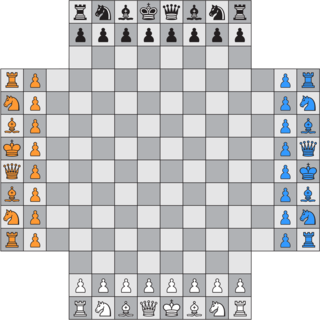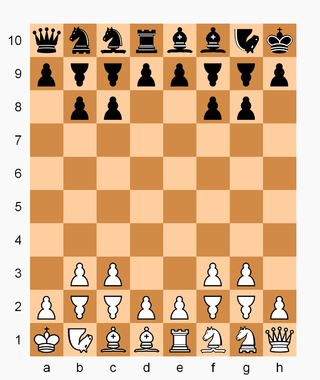Baroque chess is a chess variant invented in 1962 by Robert Abbott. In 1963, at the suggestion of his publisher, he changed the name to Ultima, by which name it is also known. Abbott later considered his invention flawed and suggested amendments to the rules, but these suggestions have been substantially ignored by the gaming community, which continues to play by the 1962 rules. Since the rules for Baroque were first laid down in 1962, some regional variation has arisen, causing the game to diverge from Ultima.
Capablanca chess is a chess variant invented in the 1920s by World Chess Champion José Raúl Capablanca. It incorporates two new pieces and is played on a 10×8 board. Capablanca believed that chess would be played out in a few decades. This threat of "draw death" for chess was his main motivation for creating a more complex version of the game.
Grand Chess is a large-board chess variant invented by Dutch games designer Christian Freeling in 1984. It is played on a 10×10 board, with each side having two additional pawns and two new pieces: the marshal and the cardinal.

Sittuyin, also known as Burmese chess, is a strategy board game created in Myanmar. It is a direct offspring of the Indian game of chaturanga, which arrived in Myanmar in the 8th century thus it is part of the same family of games such as chess, and shogi. Sit is the modern Burmese word for "army" or "war"; the word sittuyin can be translated as "representation of the four characteristics of army"—chariot, elephant, cavalry and infantry.

Crazyhouse is a chess variant in which captured enemy pieces can be reintroduced, or dropped, into the game as one's own. It was derived as a two-player, single-board variant of bughouse chess.
Tamerlane chess is a medieval chess variant. Like modern chess, it is derived from shatranj. It was developed in Central Asia during the reign of Emperor Timur, and its invention is also attributed to him. Because Tamerlane chess is a larger variant of chaturanga, it is also called Shatranj Al-Kabir, as opposed to Shatranj as-saghir. Although the game is similar to modern chess, it is distinctive in that there are varieties of pawn, each of which promotes in its own way.

Four-player chess is a family of chess variants played with four people. The game features a special board typically made of a standard 8×8 square, with 3 rows of 8 cells each extending from each side, and requires two sets of differently colored pieces. The rules are similar to, but not the same as, regular chess. There are a variety of different rule variations; most variations, however, share a somewhat similar board and piece setup.

Chu shogi is a strategy board game native to Japan. It is similar to modern shogi in its rules and gameplay. Its name means "mid-sized shogi", from a time when there were three sizes of shogi variants that were regularly being played. Chu shogi seems to have been developed in the early 14th century as a derivative of dai shogi. There are earlier references, but it is not clear that they refer to the game as we now know it.
Yari shogi is a modern variant of shogi ; however, it is not Japanese. It was invented in 1981 by Christian Freeling of the Netherlands. This game accentuates shogi’s intrinsically forward range of direction by giving most of the pieces the ability to move any number of free squares orthogonally forward like a shogi lance. The opposite is true of promoted pieces which can move backward with the same power.
Judkins shogi is a modern variant of shogi, however it is not Japanese. Credit for its invention has been given to Paul Judkins of Norwich, UK, prior to April 1998.

Kyoto shogi is a modern variant of shogi. It was invented by Tamiya Katsuya c. 1976.
Wa shogi is a large board variant of shogi in which all of the pieces are named for animals. It is played either with or without drops.
Heian dai shogi is an early large board variant of shogi as it was played in the Heian period. The same 12th century document which describes the Heian form of shogi also describes this variant. Unfortunately, this description does not give enough information to actually play the game, but this has not stopped people from attempting to reconstruct this early form of shogi. A fairly complete and playable reconstruction is outlined here.

Wolf chess is a chess variant invented by Dr. Arno von Wilpert in 1943. It is played on an 8×10 chessboard and employs several fairy pieces including wolf and fox – compound pieces popular in chess variants and known by different names.

Chesquerque is a chess variant invented by George R. Dekle Sr. in 1986. The game is played on a board composed of four Alquerque boards combined into a square. Like Alquerque, pieces are positioned on points of intersection and make their moves along marked lines ; as such, the board comprises a 9×9 grid with 81 positions (points) that pieces can move to.

Parallel worlds chess is a three-dimensional chess variant invented by R. Wayne Schmittberger in the 1980s. The gamespace comprises three 8×8 chessboards at different levels. Each side commands two full chess armies on levels 1 and 3. Level 2 begins empty and obeys its own move rules.

Falcon–hunter chess is a chess variant invented by Karl Schultz in 1943, employing the two fairy chess pieces falcon and hunter. The game takes several forms, including variations hunter chess and decimal falcon–hunter chess added in the 1950s.

Hostage chess is a chess variant invented by John A. Leslie in 1997. Captured pieces are not eliminated from the game but can reenter active play through drops, similar to shogi. Unlike shogi, the piece a player may drop is one of their own pieces previously captured by the opponent. In exchange, the player returns a previously captured enemy piece which the opponent may drop on a future turn. This is the characteristic feature of the game.
Dynamo chess is a chess variant invented by chess problemists Hans Klüver and Peter Kahl in 1968. The invention was inspired by the closely related variant push chess, invented by Fred Galvin in 1967. The pieces, board, and starting position of Dynamo chess are the same as in orthodox chess, but captures are eliminated and enemy pieces are instead "pushed" or "pulled" off the board. On any given move, a player can make a standard move as in orthodox chess, or execute a "push move" or a "pull move". A move that is either a push move or a pull move is called a "dynamo move".










